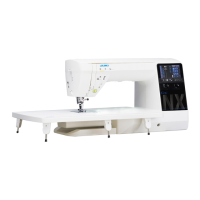
Do you have a question about the JUKI HZL-NX7 and is the answer not in the manual?
| Maximum Stitch Width | 7 mm |
|---|---|
| Maximum Stitch Length | 5 mm |
| Needle Threading System | Automatic |
| Foot Control | Included |
| Buttonhole Styles | 16 |
| Feed Dog System | Drop Feed |
| Lighting | LED |
| Knee Lifter | Yes |
| Presser Feet | Multiple included |
| Warranty | 2 years |
| Display | LCD |
| Bobbin Winding | Automatic |
| Presser Foot Lift | Automatic |
| Maximum Sewing Speed | 1, 050 stitches per minute |
| Type | Computerized Sewing Machine |
Essential safety guidelines for using the sewing machine, including warnings and dangers.
Guidelines for the maintenance and servicing of double-insulated sewing machines.
Instruction to keep the manual accessible for future reference.
Explanation of the meaning of various warning marks and pictographs used for safety.
Additional safety measures and operational guidelines to prevent hazards.
Detailed explanation of each button's name and its corresponding function on the sewing machine.
Description and identification of the icons and operational keys on the sewing machine's display.
List of accessories supplied with the machine, inside the auxiliary box, and in the packing.
Step-by-step instructions for assembling and setting up the wide table.
Instructions on how to properly connect the sewing machine to a power source.
Step-by-step instructions for safely removing and attaching sewing machine needles and checking their condition.
Information on purchasing spare needles and checking needle condition.
Detailed steps for winding thread onto the bobbin using the bobbin winder.
How to modify needle position and zigzag width using the adjusting dial.
Configuration options for the bobbin thread counter, including activation and display units.
Introduction to the machine's optional settings and their functions.
Explanation of single stitching mode and the process of combining multiple patterns.
Steps for selecting and combining patterns, including letters and symbols, for custom designs.
List and description of practical stitch patterns available on the machine.
Managing custom patterns by saving, recalling, and deleting them from user memory.
Selecting stitch patterns by inputting their specific numerical identifier.
Correcting darning patterns that appear deformed due to material or sewing conditions.
Inverting patterns horizontally or vertically for different design effects.
Fundamental steps for sewing a straight stitch, including direction changes and needle stop position.
Steps for folding fabric and performing blind stitches for hems.
Fine-tuning the needle entry point for proper blind stitch formation.
Techniques for sewing lace or feather patterns in combination to create decorative effects.
How to sew patterns with gradually changing zigzag width for tapering effects.
Adjusting the size of tapering sections for different sewing applications.
Overview of various buttonhole stitch patterns and their applications.
Steps for setting the presser foot, button, sensor pin, and using the clamping plate.
Modifying buttonhole width and seam density using adjusting dials.
Adjusting the overall seam width of buttonholes for different applications.
Step-by-step guide for sewing manual 2-step buttonholes.
Final steps for completing manual 2-step buttonholes, including bartacks and finishing.
Steps for setting up the machine and presser foot for free motion quilting.
Tips for locking stitches and operating the feed dog during free motion quilting.
Catalog of optional accessories available for enhancing sewing capabilities.
Instructions for installing the magnifier and spool holder accessories.
A comprehensive catalog of all stitch patterns available on the sewing machine.
Catalog of available letters, numbers, and symbols for custom text creation.
